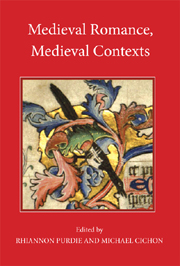Book contents
- Frontmatter
- Contents
- Acknowledgements
- Contributors
- Abbreviations
- Introduction: Romance and its Medieval Contexts
- 1 The Pleasure of Popular Romance: A Prefatory Essay
- 2 Representations of Peasant Speech: Some Literary and Social Contexts for The Taill of Rauf Coilyear
- 3 ‘As ye have brewd, so shal ye drink’: the Proverbial Context of Eger and Grime
- 4 Ekphrasis and Narrative in Emaré and Sir Eglamour of Artois
- 5 What's in a Name? Anglo-Norman Romances or Chansons de geste?
- 6 ‘For Goddes loue, sir, mercy!’: Recontextualising the Modern Critical Text of Floris and Blancheflor
- 7 Roland in England: Contextualising the Middle English Song of Roland
- 8 Romance Baptisms and Theological Contexts in The King of Tars and Sir Ferumbras
- 9 Modern and Medieval Views on Swooning: the Literary and Medical Contexts of Fainting in Romance
- 10 Walking (between) the Lines: Romance as Itinerary/Map
- 11 Romances of Continuity in the English Rous Roll
- 12 ‘Ex Libris domini duncani / Campbell de glenwrquhay/ miles’: The Buik of King Alexander the Conquerour in the household of Sir Duncan Campbell, seventh laird of Glenorchy
- 13 ‘Pur les francs homes amender’: Clerical Authors and the Thirteenth-Century Context of Historical Romance
- Index
- Volumes already published
11 - Romances of Continuity in the English Rous Roll
Published online by Cambridge University Press: 12 September 2012
- Frontmatter
- Contents
- Acknowledgements
- Contributors
- Abbreviations
- Introduction: Romance and its Medieval Contexts
- 1 The Pleasure of Popular Romance: A Prefatory Essay
- 2 Representations of Peasant Speech: Some Literary and Social Contexts for The Taill of Rauf Coilyear
- 3 ‘As ye have brewd, so shal ye drink’: the Proverbial Context of Eger and Grime
- 4 Ekphrasis and Narrative in Emaré and Sir Eglamour of Artois
- 5 What's in a Name? Anglo-Norman Romances or Chansons de geste?
- 6 ‘For Goddes loue, sir, mercy!’: Recontextualising the Modern Critical Text of Floris and Blancheflor
- 7 Roland in England: Contextualising the Middle English Song of Roland
- 8 Romance Baptisms and Theological Contexts in The King of Tars and Sir Ferumbras
- 9 Modern and Medieval Views on Swooning: the Literary and Medical Contexts of Fainting in Romance
- 10 Walking (between) the Lines: Romance as Itinerary/Map
- 11 Romances of Continuity in the English Rous Roll
- 12 ‘Ex Libris domini duncani / Campbell de glenwrquhay/ miles’: The Buik of King Alexander the Conquerour in the household of Sir Duncan Campbell, seventh laird of Glenorchy
- 13 ‘Pur les francs homes amender’: Clerical Authors and the Thirteenth-Century Context of Historical Romance
- Index
- Volumes already published
Summary
Both romance and genealogy depend on the idea of continuity: romance because it is narrative, obviously, and genealogy because its function is to connect the present with the past, to make links and trace lineage. In both romance and genealogy, continuity – fictive or historical – may be constructed or foregrounded when issues of identity or inheritance are at stake. In late medieval England, especially, the interests of chivalric romance and of genealogy converged powerfully; certainly they did so in the work of a fifteenth-century Warwickshire chantry priest, John Rous, whose armorial rolls pressed both romance and genealogy into the service of his patrons, the earls of Warwick. I begin this discussion by exploring briefly a genealogical conundrum related to Warwick's influential local romance, that of Guy of Warwick, to raise the question of whether Rous was writing romance or history – or both.
One theory about the origins of the Anglo-Norman romance Gui de Warewic, the poem on which subsequent medieval versions, including the Middle English Guy of Warwick, were based, is complicated by a small genealogical problem. Here is the theory. It has been noticed that the Anglo-Norman Gui is at great pains to imply that the lords of Wallingford were hereditary stewards of the earls of Warwick. Now Wallingford had been held before the Conquest by Wigot (Wigod), whose name might be rendered in Anglo-Norman as Gwido and thus as Gui; Wigot's daughter Ealdgyth married a Norman, Robert d'Oilly, who may have been a sheriff of Warwick and who held lands in Warwickshire from Thurkil of Arden, one of only three or four Englishmen who still had substantial property at the time of the Domesday survey.
- Type
- Chapter
- Information
- Medieval Romance, Medieval Contexts , pp. 149 - 160Publisher: Boydell & BrewerPrint publication year: 2011



